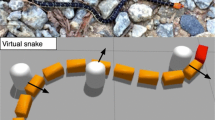Abstract
This paper proposes models of short-range sensors. The target application is the simulation of the environment perception for an autonomous biped robot that evolves in an unknown surroundings. These proximity sensors can be of different types, emulating real sensors such as laser range finders, ultrasonic sensors or reflectance sensors. These sensors will be used to provide real-time local information about the environment to the robot in a simulation. Strategies to avoid and circumvent an obstacle can then be easily tested.
Access this chapter
Tax calculation will be finalised at checkout
Purchases are for personal use only
Preview
Unable to display preview. Download preview PDF.
Similar content being viewed by others
References
A. Witkin and Z. Popovic. Motion Warping. SIGGRAPH’95, 105–108, 1995.
B. Blumberg and T. Galyean. Multi-level Direction of Autonomous Creatures for Real-Time Virtual Environments. SIGGRAPH’95, 47–54, 1995.
O. Renault, N. Magnenat-Thalmann and D. Thalmann. A Vision-based Approach to Behavioral Animation. The Journal of Visualization and Computer Animation, 1(1):18–21, 1991.
H. Noser,). Renault, D. Thalmann and N. Magnenat-Thalmann. Navigation for Digital Actors Based on Synthetic Vision, Memory, and Learning. Computer & Graphics, 19(1):7–19, 1995.
B. Espiau. An Overview of Local Environment Sensing in Robotics Applications. Sensors and Sensory Systems for Advanced Robots, Springer-Verlag, 43:125–151, 1988.
F. Sillion and C. Puech. Radiosity and Global Illumination. Morgan Kaufmann Publish., San Francisco, 1994.
F. Cazals and G. Drettakis and C. Puech. Filtering, Clustering and Hierarchy Construction: a New Solution for Ray Tracing Very Complex Environments. Eurographics’95, Maastricht, the Netherlands, September 1995.
C. L. Vaughan, B. L. Davis and J. C. O’Connor. Dynamics of Human Gait. Human Kinetics Publishers, Champaign, Illinois, 1992.
Y. Roth-Tabak and R. Jain. Building an Environment Model Using Depth Information. Computer, 22(6):85–90, June 1989.
A. Elfes. Occupancy Grid: A Stochastic Spatial Representation for Active Robot Perception. Proceeding of the Sixth Conference on Uncertainty in AI, July 1990.
Author information
Authors and Affiliations
Editor information
Editors and Affiliations
Rights and permissions
Copyright information
© 1999 Springer-Verlag Wien
About this paper
Cite this paper
France, L., Girault, A., Gascuel, JD., Espiau, B. (1999). Sensor Modeling for a Walking Robot Simulation. In: Magnenat-Thalmann, N., Thalmann, D. (eds) Computer Animation and Simulation ’99. Eurographics. Springer, Vienna. https://doi.org/10.1007/978-3-7091-6423-5_18
Download citation
DOI: https://doi.org/10.1007/978-3-7091-6423-5_18
Publisher Name: Springer, Vienna
Print ISBN: 978-3-211-83392-6
Online ISBN: 978-3-7091-6423-5
eBook Packages: Springer Book Archive




